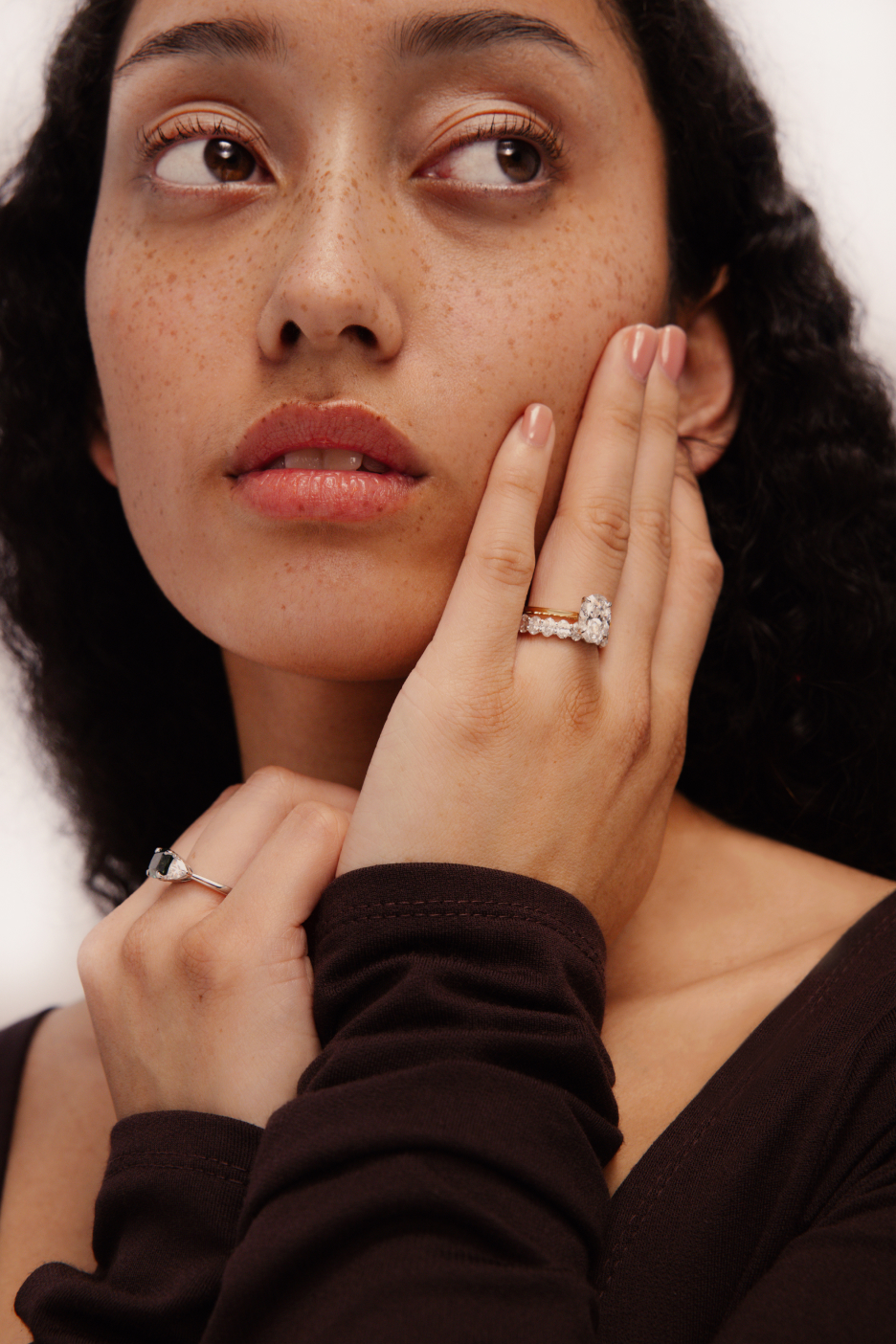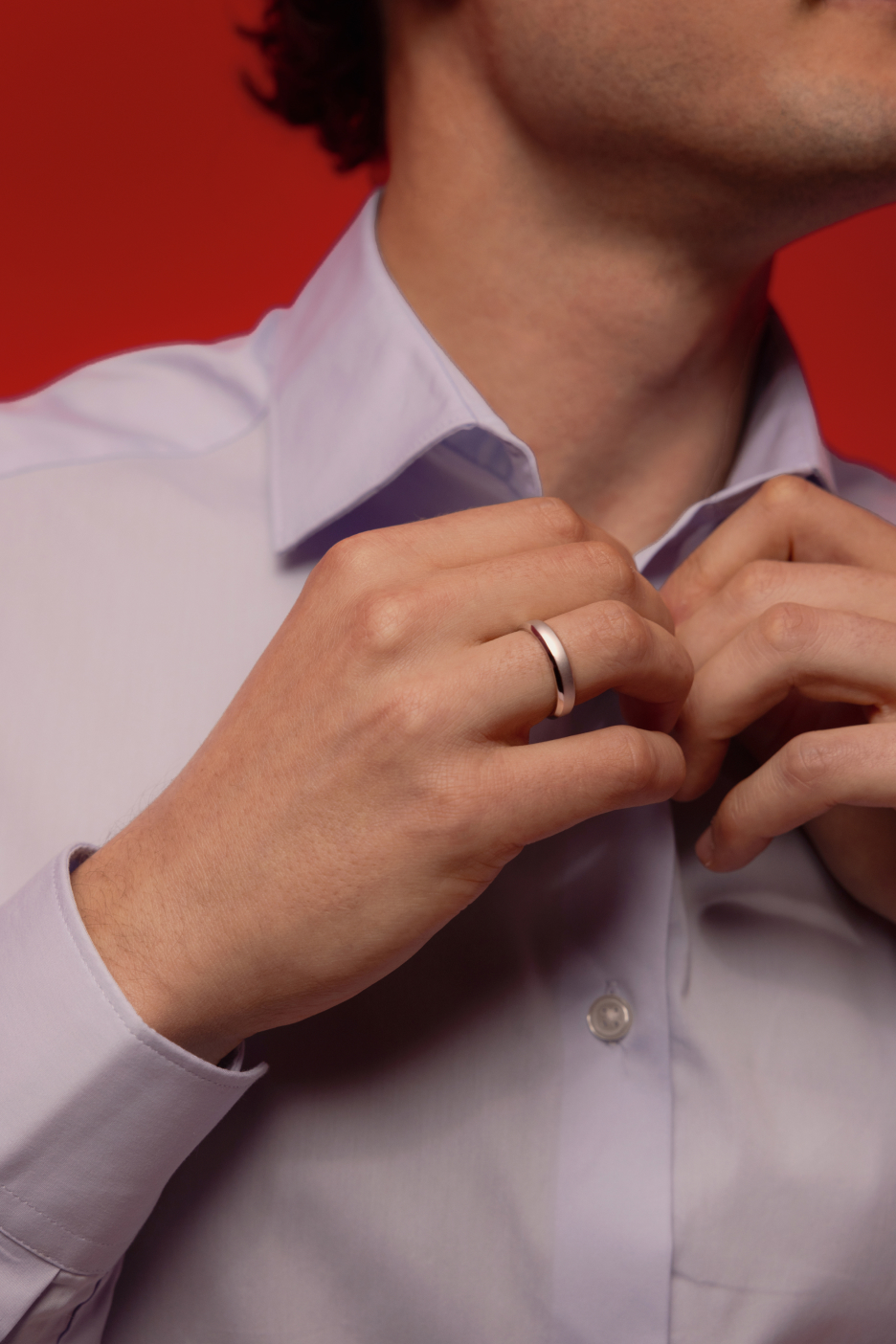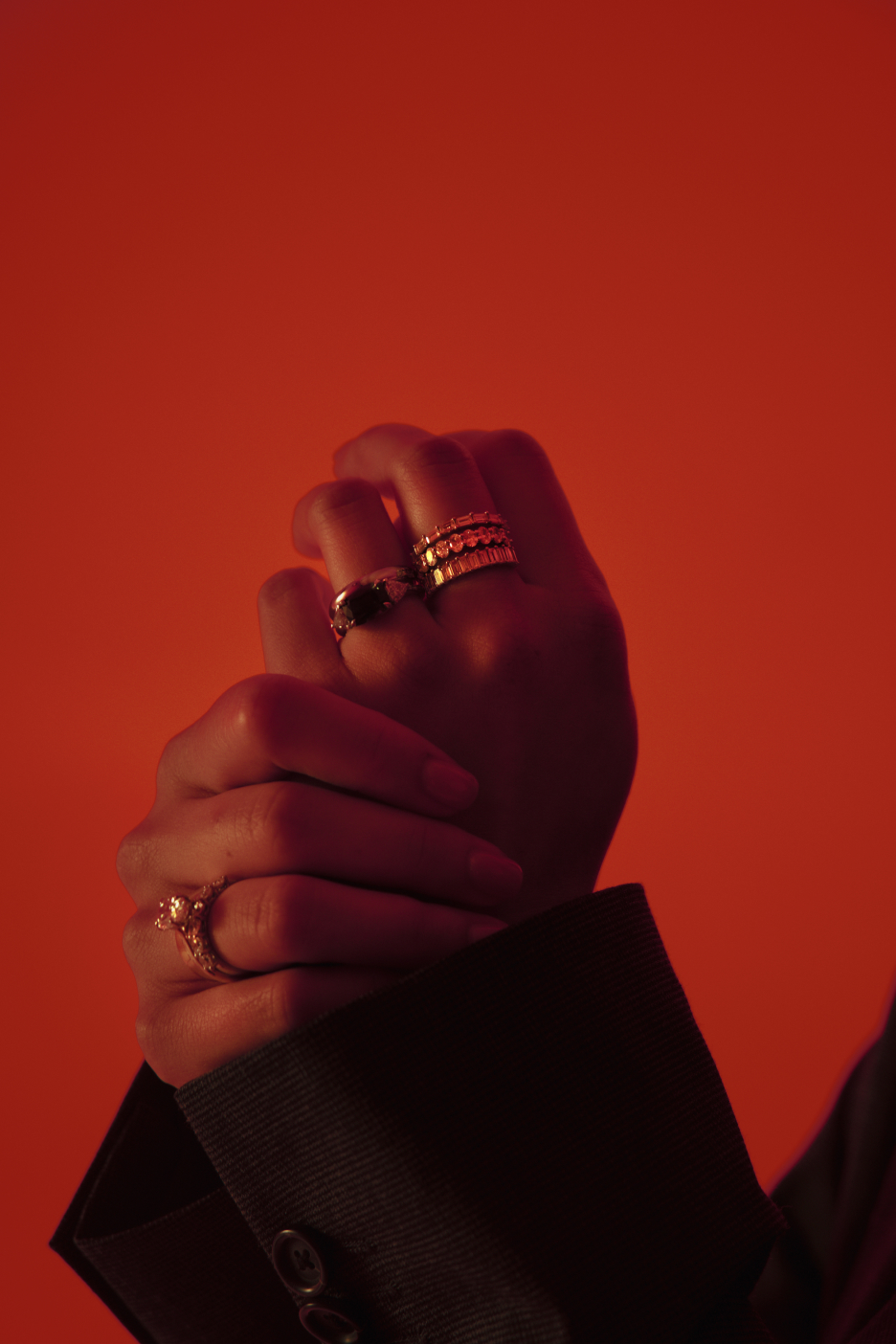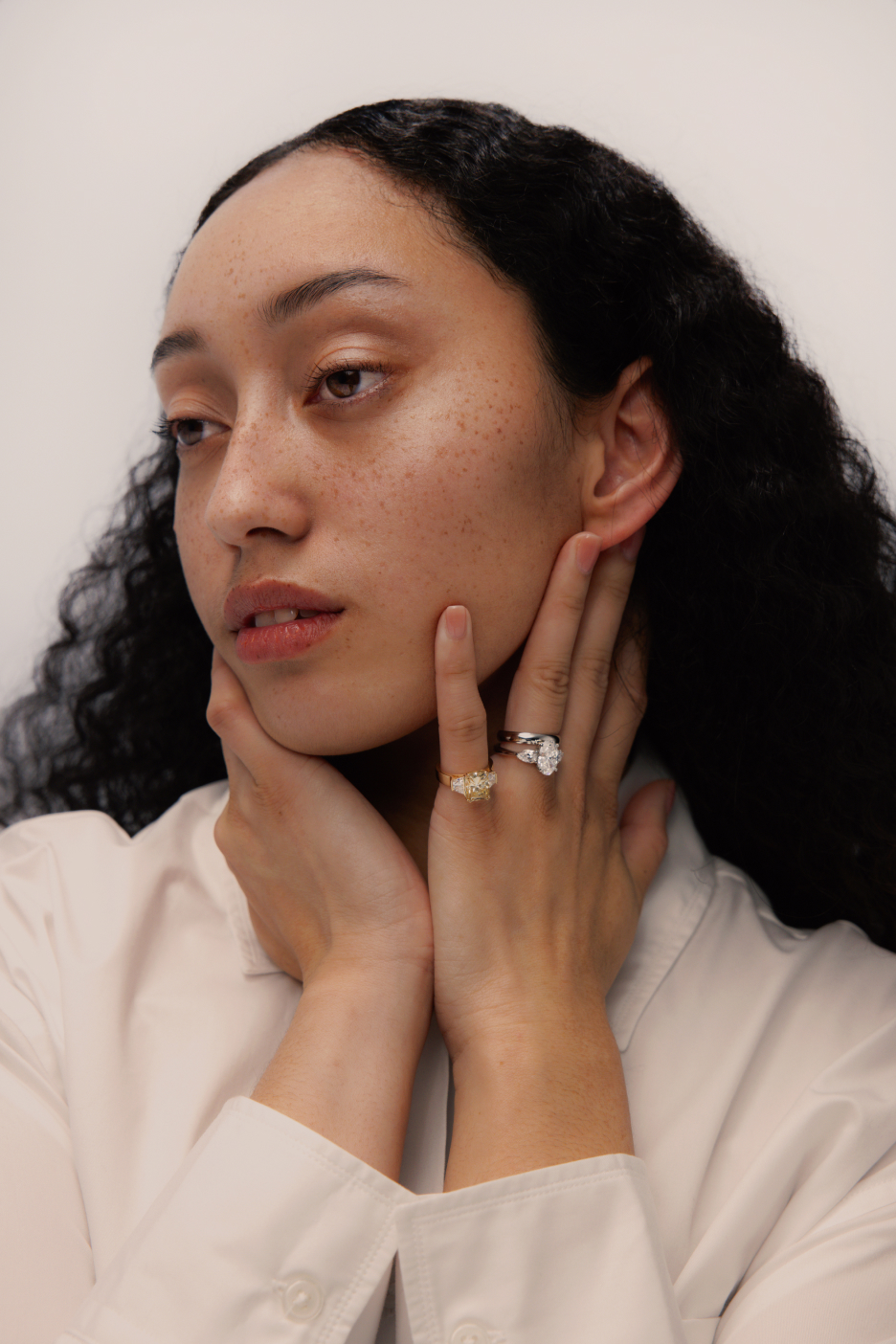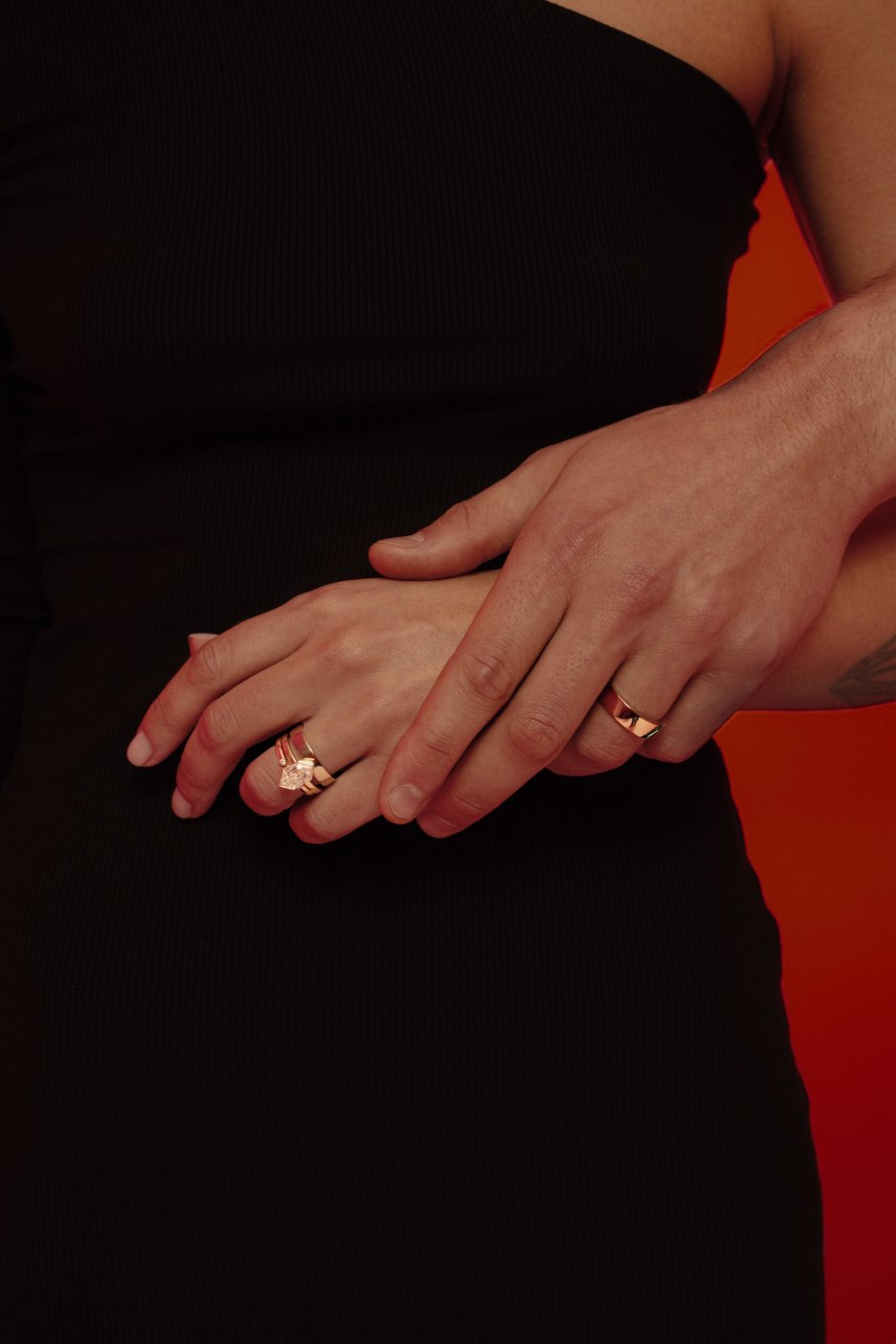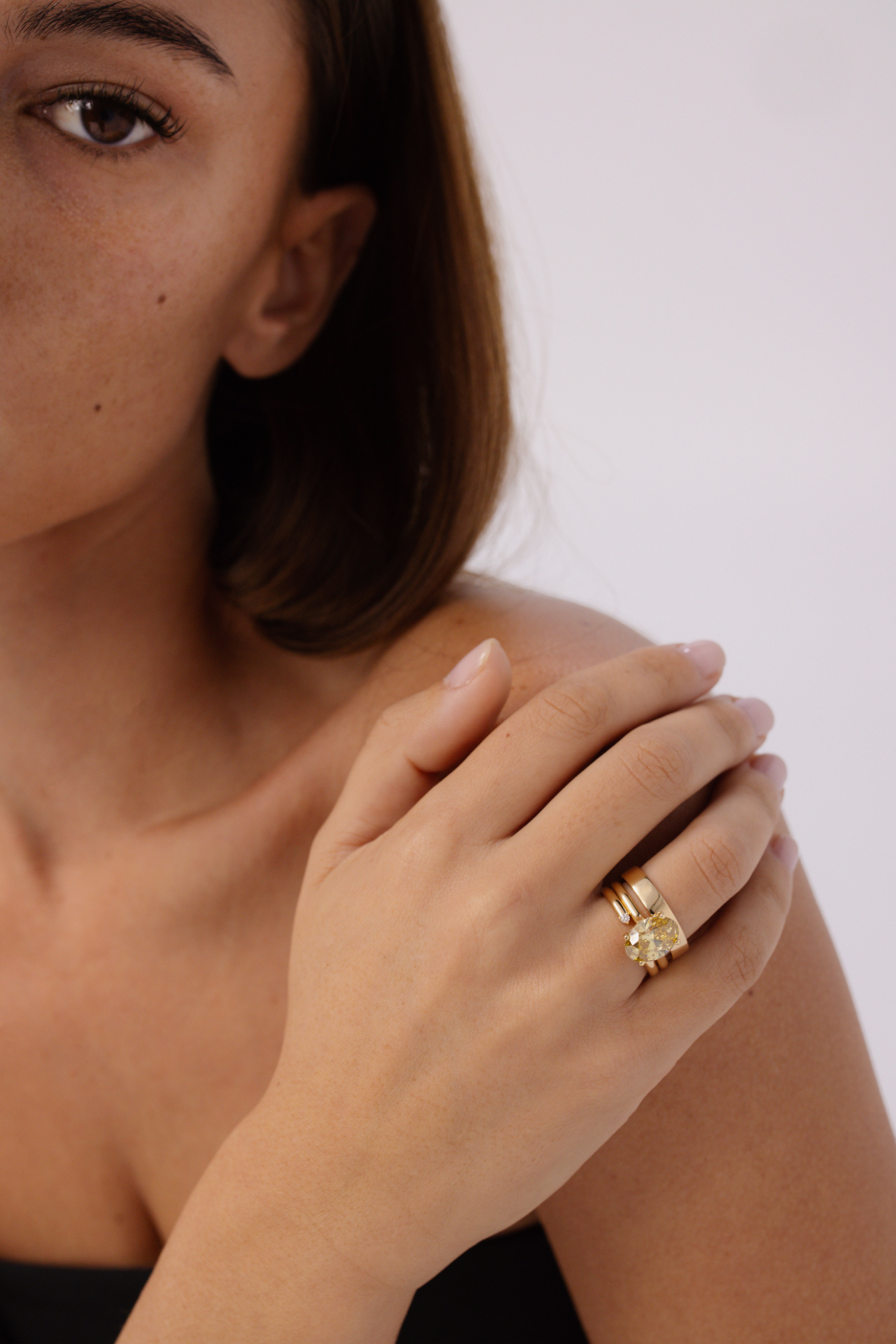The 4Cs of a diamond (and what they don't tell you)

The 4Cs of a diamond are carat, cut, clarity and colour. But this does not guarantee that you will get the best diamond that the eye can see, nor the diamond quality you may be after. This article will walk through:
The 4Cs.
What you should and shouldn’t pay for.
Things that sit outside the 4Cs that go into picking the best quality stone.
Why you shouldn’t buy from online ring builders.
The 4C’s of diamonds
When you start on your engagement ring buying process, the 4Cs is a great first step into choosing a high quality stone.
Carat
Carat is a measure of weight and not size. And some diamond shapes (also known as cuts) appear larger than others. This is because some cuts have a larger surface area compared to its depth.
1 carat is equivalent to 200 milligrams. 2 carats is equivalent to 400 milligrams, and so on. But as carat increases, surface area doesn’t necessarily follow suit. The two graphs below show this.


The smallest appearing diamond (due to its surface area) for any given diamond carat weight is the round cut, (or the Tiffany cut). This is because the cut is optimised for sparkle and not surface area. Other shapes such as the emerald or Asscher cut have a larger surface area compared to its depth and they are not specifically made to sparkle — instead they are optimised for their internal faceting and step-cut.
This is where most jewellers go wrong. They try and sell you on carat with the mistaken assumption that it will make your diamond sparkle more. This is definitely not the case. Bigger doesn’t necessarily mean more sparkly — let alone better. Also, when it comes to picking out an engagement ring, at Four Words we are finding more couples designing their own custom bespoke ring as opposed to just trying to get the biggest carat engagement ring.
The other thing you need to watch out for is total carat weight.
Total carat weight is the total weight of diamonds on the ring, but not of any single diamond. Some jewellers report on total carat weight especially when they use lots of smaller stones which add up to much more.
For example, 10 x 0.1 carat diamonds have a total carat weight of 1 carat but there is no single 1 carat stone on the ring. This is a tactic used to hide the true size of a diamond so that the jeweller can charge more.
At Four Words we always report the carat of each individual diamond.
Cut
Cut is the most important, and another commonly misunderstood component of the 4Cs. It refers to the quality of a diamond’s angles, proportions, symmetrical facets, brilliance, fire, scintillation and finishing details. Both IGI and GIA grade cut on a scale of Ideal, Excellent, Very Good, Good, Fair and Poor. The simplest way to think about cut is ‘light performance’. But only round brilliant diamonds have a globally accepted grading for cut.

All other diamonds do not have a cut grade and should be visually inspected to decide on their quality. And because each diamond shape can vary, making a good decision on cut for anything outside of a round diamond requires practice and skill.
Cut also happens to be the most important component of the 4Cs. It has the biggest influence on a round diamond’s sparkle. And for other diamond shapes, it is the biggest determinant of the quality of the diamond itself.
So if you are in the market for a round cut, three things go into cut: the cut itself, polish and symmetry. Each of these are measured on the same scale — Ideal, Excellent, Very Good, Good, Fair and Poor. Polish refers to how shiny and reflective the surface is. Symmetry is self-explanatory, and cut refers to the angles and dimensions to which the round is cut to optimise for sparkle.
If you were to buy from Tiffany & Co, they would talk about their triple excellent standard. Take nothing away from Tiffany & Co., they pioneered the round in the early 20th century. But the triple excellent standard is not the highest quality. So when you buy from Four Words, we will only select Ideal cut diamonds, including those with hearts and arrows (an even higher quality round with internal symmetry using the latest in cutting technology).
To make things even more confusing, it is important to note that even with an Excellent cut, it doesn’t necessarily mean it is a high-quality diamond. Almost 55% of all diamonds sold online are Excellent cuts — but colour and clarity also need to be taken into consideration — as well as things outside of the 4Cs.
This is why at Four Words we strongly discourage buying from online ring builders. The price of getting something custom bespoke with our dedicated designers and jewellers with an eye for detail and quality is not that much different (sometimes even cheaper) than online ring builders where you need to pick your own diamond and setting without any expert advice or support. We have a strict set of parameters using computer vision models and optical geometry when selecting diamonds to ensure you always get the best and brightest diamonds.
Clarity
Clarity refers to the absence of imperfections (also known as inclusions) inside, or on the surface of a diamond or gemstone. These are usually formed while the diamond is grown or formed, or during the cutting process.
Unlike cut, clarity is graded across all diamond shapes. Also, grading takes into account the number, size, nature and position of the inclusions and how it affects the overall appearance of the diamond.
So while no diamond is perfectly pure (lab grown diamonds come close), the closer it comes, the higher the value. The opposite is also true — the greater the number and size of inclusions a diamond has, the less valuable it will be.
The two big diamond grading companies — GIA and IGI share the same method and measure for clarity:
FL (flawless): No external or internal inclusions visible to a trained eye with 10x magnification
IF (internally flawless): Only minor surface blemishes but not internal inclusions visible to a trained eye under 10x magnification
VVS1-2 (Very very slightly included): Few, very small inclusions and/or finish faults, difficult for a trained eye to see under 10x magnification.
VS1-2 (Very slightly included): Very small inclusions and/or finish faults, somewhat difficult for a trained eye to see under 10x magnification.
SI1-2 (Slightly included): Small inclusions and/or surface blemishes are easily seen under 10x magnification, but not visible face-up to a naked trained eye.
I1 (Imperfect 1): Inclusions and/or finish faults visible under 10x magnification, but hard to see with the naked human eye
I2 (Imperfect 2): More and/or larger inclusions and surface blemishes are easily seen without 10x magnification. Some diminished brilliance within the stone.
I3 (Imperfect 3): Many and/or very large inclusions and surface faults are easily seen without 10x magnification. The severity of the inclusions obviously disfigures the stone.
At Four Words we only pick the best diamonds that the eye can see. Our minimum standard is VS1, if we can’t find anything up to our standard, we’ll upgrade you for free.
Colour
Diamond colour has a huge bearing on your overall diamond’s appearance. As part of the 4Cs, it refers to the colour within a diamond. And it ranges from colourless (D-E-F) to light yellow-brown (J-Z). The higher the colour grade, the closer the diamond is to being colourless.
At Four Words we only work with the best diamonds that the eye can see. And it is for this reason we only work with D-E-F coloured diamonds (colourless to the naked eye). We believe that this is particularly important because the colour (or a lack of it) maximises sparkle. The minimum colour that we work with is F and if we can’t find you a suitable stone, we will upgrade you in either carat size or colour grade for free.
What about coloured diamonds?
Coloured diamonds have their grading system. Often termed fancy coloured diamonds, their colour is graded on: hue, saturation and tone.
Diamond hue
The formal definition of a coloured diamond is one that diamonds that fall outside of the standard colourless spectrum. Pinks, blues, and greens are the hues that typically have the highest prices. In every instance, even minor variations in hue may have a significant effect on the price.
As long as the colour is visible when the diamond is held with the face-up, it is considered to have a fancy colour, even if the tone is light and the saturation is low.

Diamond saturation
Saturation refers to the degree to which the primary hue of the diamond's colour is expressed in terms of strength or intensity.
The saturation of lighter diamonds is described as "light," "intense," or "vivid.” When referring to darker diamonds, the words "dark" or "deep" are used.
Imagine a glass of red food colouring sitting next to a glass that is two-thirds water and one-third food colouring. This is a helpful approach to saturation.

Tone
The lightness or darkness of the diamond's appearance is referred to as its tone. The percentages of brown, black, grey, and white that are present in the stone are often used to make this determination.
Picture the glass with the food colouring again. If you were to add a little amount of black food colouring to the red, the colour would still be red, so the saturation would be the same, but the tone would be darker.

Some Things That The 4Cs Don’t Tell You
While the 4Cs are a great starting point for choosing a diamond, we have spent a lot of time and developed expertise to better understand what goes into picking the best diamond that the eye can see.
Windowing and Extinction
Stepped cut diamonds (i.e., emeralds, Asschers etc) have different light performance properties compared to Rounds and ovals. They are intentionally not that shiny and their beauty lies in their straight lines as light refracts from each cut. But with this can come windowing and extinction.
This is where poor cut emeralds either leak too much light appearing clear, like a window; or don’t refract enough light and create very dark areas. You want to avoid diamonds like this.

One frustrating part with selecting a diamond (especially with an online ring builder) is the amount of time you need to put into finding a well cut diamond. We only work with the top 2% of diamonds in the world by visually inspecting them – which means you get the best diamond that the eye can see.
Bowties on Elongated Cuts
Elongated cuts such as the oval, pear and marquise diamonds, especially at larger sizes suffer from something jewellers call bowties.
A bowtie is a dark area which is near the centre of the diamond. They look like two black triangles. All elongated diamonds are affected by this effect to some degree. You ideally want to avoid diamonds with dark prominent bowties. The reason they are not the best quality diamond that the eye can see is that it darkens your diamond, changing how it looks and sparkles.

The other thing about elongated cuts is that they can have dark tips. This typically tends towards yellow, brown or grey. And this happens because of the way the light is refracted and reflected through the diamond. Again, this can make your diamond look cheap. So what should you do? Work with a respected jeweller that goes above and beyond in choosing you the best diamond that you can see without necessarily over-paying.
Surface Area to Depth Ratios
Another thing that the 4Cs don’t tell you is about surface area to depth ratio. This is important especially for balancing the visual appearance of any given carat (remember carat is a weight not a size), to its light performance.
Below are two Asscher cut diamonds with exactly the same grades as per the 4Cs but with wildly different light performance (something not shown on a grading certificate).

Each diamond cut has an ideal surface area to depth ratio, and definition of eye-clean. So while a larger surface will make your diamond appear larger, it won’t have the same brilliance to something more balanced.
Conversely, a diamond that has too much depth can leak light from the bottom of the diamond meaning that the diamond isn’t as sparkly. Furthermore, the light may not spread as effectively across the surface, making it also appear smaller and less lively.
CVD strain
CVD refers to a method to growing lab grown diamonds. The process involves introducing a gas mixture, typically methane and hydrogen, into a vacuum chamber and then activating and breaking down the molecules of the gases with microwaves. The carbon atoms are deposited onto a substrate, where they accumulate and form diamond crystals over time.
Because lab grown diamonds are not grown in the exact same way as mined diamonds, CVD strain refers to specific “blemishes” uniquely characteristic to CVD grown diamonds.
CVD strain refers to the internal stresses and imperfections that occur within a diamond as it grows layer by layer in the CVD process. These stresses are often due to variations in temperature and deposition rates during the diamond growing process and appear as “strain patterns”.
CVD strain can influence the optical properties of a diamond by impacting the diamond’s brilliance (making it less sparkly).
At Four Words, when you choose a lab grown diamond, we check for CVD strain and make sure your diamond does not have any visible blemishes. And as the lab grown diamond industry continues to evolve with new technology, we continue to hone in on our methods to pick the best diamonds that the eye can see. And by doing so, we only work with the top 2% of diamonds in the world.
These are just some of the things that we pay attention to when choosing you the best diamond that the eye can see. We also use computer models, optical geometry and a raft of other measures so that your diamond sparkles even after a lifetime of wear.
Why You Shouldn’t Buy From An Online Ring Builder
An online ring builder is when you are asked to pick all of the components of your ring, typically with filters that you need to choose. A couple of examples are shown below:


When you work with a bespoke jeweller like Four Words, it comes down to working with a designer who can turn your ideas into life, and a much high standard when it comes to craftmanship, picking out the best gemstone that the eye can see, and post-service care. To top it all off, our prices are competitive — sometimes even better than online ring builders.
Our designers turn your ideas to life
When you work with Four Words, you can tell the difference between our rings and those bought from online ring builders. We invest considerable time in getting the brief right. We take into consideration your unique story, your lifestyle, what you do for a living to design and craft the perfect piece of jewellery that will last more than a lifetime.
Travel a lot? We will recommend a replica ring at a considerably lower price. Have an active lifestyle? Then a lower profile ring will ensure that your ring isn’t easily damaged.
The other thing is that when you buy a ring using a ring builder, you are playing with a limited number of options. Lots of our clients have come in with one idea and ended up buying something completely different. Why? Because after working together on a brief, and trying some rings on, they have found something that is more suited to what they were really after.
Buying an engagement ring should be fun, exciting and interesting. Buying an engagement ring shouldn’t be the same process as buying a pizza. So when you buy an engagement ring from Four Words, you will spend time with a designer, get the opportunity to talk through designs, and have the ability to pick up the phone or email us directly.
Picking a diamond is more than just the 4Cs
Each diamond cut comes with its unique grading characteristics. Emeralds can suffer from windowing and extinction, elongated cuts can suffer from bowties, and some lab grown diamonds can come with CVD strain. And the majority of diamond shapes can’t objectively be measured on cut. These are just some of the things that we look out for (and other jewellers don’t) when we pick your diamond. So how do you get the best looking diamond that the eye can see without overpaying? By working with Four Words.
You won’t even need to pick the diamonds or gemstones yourself. We will do all the hard work and provide you videos with an explanation for why we chose the diamond that we did. Also, if we can find you a better quality stone, or larger carat, we will typically upgrade you for free.
Online ring builders are based on components — not on each individual piece
Online engagement ring builders are based on mass-produced ring components, and not on treating each engagement ring as its own unique piece. This means that any variation in the diamond means that you won’t get a perfect fit.
Below is just one example. The melee diamonds below are forced into the prongs which will mean they are not going to be sparkly — let alone look good.

With online ring builders, you are also more likely to get structural issues with your engagement ring. The example below shows the prongs not holding the diamond tightly and the diamond not sitting flush in its basket.

Compare this with rings from Four Words. All our rings have an exquisite finish. before you get your ring, we check it for structural and aesthetic imperfections. And in the case it doesn’t meet our standard, we work with our jewellers to hand-finish your ring so its perfect.
Below are two Four Words rings to compare.
The first ring shows the attention to detail that we pay to the snug fit of the diamond in its basket and the tightness of the prongs to keep the diamond safe.

The image below shows how we maximised each diamond in the band with it progressively becoming smaller. The prongs also account for this in a way to maximise each diamond’s sparkle.

Post-purchase care
When you work with Four Words, we get to know you, your partner and your story. So when we design and craft your ring, we know know exactly why and how your engagement ring needs to look and feel. And that extends to our post-purchase care.
All of our jewellery over $10000 comes with a lifetime manufacturing warranty, and a free annual after care plan. This includes tightening of the prongs and and a deep clean of your engagement ring.
Common Questions
The 4Cs of a diamond will be described on its independently verified certificate. These are typically from GIA or IGI. Some large retailers in New Zealand don’t use independently verified certificates and this is a red flag because the diamond is not independently graded.
All Four Words lab grown diamonds above 0.5 carats come with an independent grading certificate from either GIA or IGI.
The lower the clarity grade, the lower the price. But it isn’t necessary to go for the highest possible clarity grade because the difference is not noticeable to the naked eye. At Four Words we opt for VVS1-VVS2 as a minimum standard.
In order of importance, cut, colour, clarity and carat. It is better to have a high quality diamond in a smaller size than a poor quality larger carat diamond.
G coloured diamonds are better than H diamonds because H diamonds have a more yellow-brown tint. At Four Words, we use diamonds in the DEF range — the highest possible grade for colour.
The sparkliest diamond is the round cut. It is specifically cut to maximise light performance. The drawback of the round cut though is that it has the smallest surface area to depth ratio. This means it appears smaller than all other diamond shapes.
Tiffany diamonds are also known as triple excellent round cut diamonds. Round diamonds have since become better and the triple excellent standard is no longer the highest standard. Ideal cut rounds with hearts and arrows are now the best cut round diamonds. This is the typical standard of a Four Words round.
